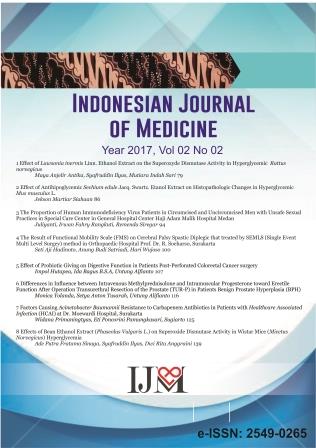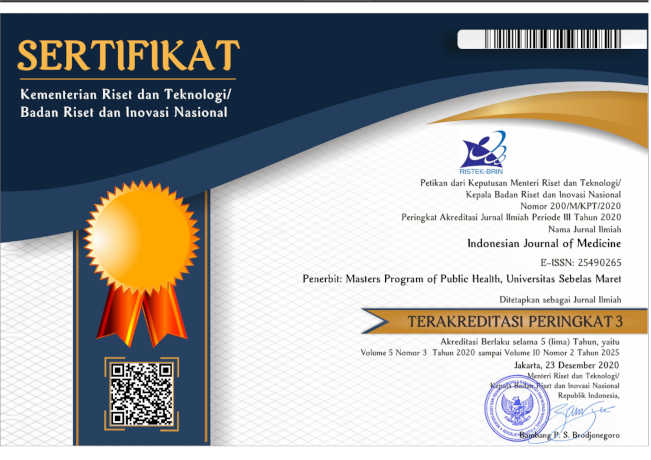The Result of Functional Mobility Scale (FMS) on Cerebral Palsy Spastic Diplegic that treated by SEMLS (Single Event Multi Level Surgey) method in Orthopaedic Hospital Prof. Dr. R. Soeharso, Surakarta
DOI:
https://doi.org/10.26911/theijmed.2017.2.2.53Abstract
Background: Cerebral Palsy is a permanent non-progressive brain disorders that occur in early childhood where abnormalities in the brain due to damage on immature brain can cause movement disorders and postural dysfunctionNowadays, the treatment of choice for CP Spastic diplegic is using SEMLS (Single Event Multi Level Surgery). There was many scoring to evaluate outcome of SEMLS, but only a few scoring system that can evaluate changing after SEMLS. Functional Mobility Scale (FMS) is an outcome measure designed to evaluate mobility of children with cerebral palsy (CP). FMS has been shown to detect both improvement and deterioration in mobility status during the rehabilitation period following multilevel orthopaedic surgery in children with spastic diplegic
Subjects and Method:This was a cross sectional observasional study. The sample are obtained by sensus from January 1st 2014 untill March 1st 2015. The patient’s characteristic that we include in this study are gender, age when the patient had a surgery, and where the contracture are involved. We evaluate the outcome using FMS before operation, 3 month, 6 month, 9 month, and 12 month after operation on three different distance (5, 50, 500 meter) that represent home, school, and community. After that we analyze the result using regression logistic model to better understands about changes and time of changes on patient after SEMLS procedure. We also analyze the corelation between age, sex, and location of contracture with the outcome after SEMLS procedure
Result : 51 patients were reviewed and identified, there were 31 males (61%) and 20 females (39%), mean age when the patient was operated was 8.07 years old, with the most common cases are CP Spastic Diplegic with hip, knee, ankle contracture bilateral about 41 patient (80.3%), knee ankle bilateral about 7 patient (13.2%), and hip ankle bilateral about 3 patient (5.88%). From evaluation of FMS scoring, we found most patient had an improvement on their mobility after SEMLS procedure (OR > 1), with the time changes for 5 and 50 meters distance is at six months (OR : 1.52) and (OR= 1.47), and 500 meters is at 12 months (OR= 3.45). We also found no significant relationships (p value > 0.05) between age (p value= 0.632), sex (p value= 0.576) and location of contracture (p value= 0.222) with the outcome of the FMS after SEMLS
Conclusion: We found that SEMLS gives a good result to increased mobility of patient with CP Spastic Diplegic. FMS Score were able to asses the outcome of SEMLS procedure, and also responsive to change that occur after SEMLS. Age, sex, and contracture’s location were not significantly influence the FMS outcome after SEMLS
Keywords: CP Spastic Diplegic, SEMLS (Single Event Muti Level Surgery), FMS (Functional Mobility Scale).
Correspondence: Seti Aji Hadinoto. Masters Program of Family Medicine, Sebelas Maret University, Jl. Ir. Sutami 36 A, Surakarta 57126, Central Java.
Indonesian Journal of Medicine (2017), 2(2): 100-106
https://doi.org/10.26911/theijmed.2017.02.02.04
References
Abdel H. Cerebral Palsy. http://eme-dicine.medscape.com/article/1179555-overview#a4.
Adair B, Said C, Rodda J, et al., (2012). Psychometric properties of functional mobility tools in hereditary spastic paraplegia and other childhood neurological conditions. Developmental Medicine & Child Neurology, 596 – 605.
Bache E, Selber P, Graham HK (2013). The management of spastic diplegia.88-104. Current Orthopaedics. Elsevier Science Ltd.
Bax M, Goldstein M, Rosenbaum P, Leviton A, Paneth N, Dan B, Jacobsson B, Damiano D (2005). Executive Committee for the Definition of Cerebral Palsy. Proposed definition and classifycation of cerebral palsy. Dev Med Child Neurol, 47: 571–576.
Bell KJ, Ounpuu S, DeLuca PA, Romness MJ (2002). Natural progression of gait in children with cerebral palsy.J PediatrOrthop, 22(5): 677-82.
Berker N, Yalcin L (2010). The Help Guide To Cerebral Palsy: Second edition. Global Help.
Bleck EE (1987). Orthopaedic Management in Cerebral Palsy 2nded, Michigan: Mac Keith.
Chounti A, Heagglund G, Wagner P, et al., (2013). Sex differences in cerebral palsy incidence and functional ability: a total population study. Acta Pædiatrica: 712–717
Graham HK, Harvey A (2007). Assesmentof Mobility after Multi – Level Surgery for Cerebral Palsy. J Bone Joint Surg [Br], 89-B:9934.
Harvey A, Baker R, Morris M, et al., (2009). Does parent report measure performance? A study of the construct validity of the Functional Mobility Scale. Developmental Medicine & Child Neurology: 181 – 185.
Harvey A, Morris M (2008). Systematic review of measures of activity limitation for children with cerebral palsy. Developmental Medicine & Child Neurology, 50: 190–198.
Harvey A, Graham HK, Morris M (2007). The Functional Mobility Scale: ability to detect change following single event multilevel surgery. Developmental Medicine and Child Neurology, 49: 603.
_______ (2010). Reliability of the Functional Mobility Scale for Children with Cerebral Palsy.Physical & Occupational Therapy in Pediatrics, 30(2).
Harvey A, Rosenbaum P, Hanna S, et al., (2012). Longitudinal Changes in Mobility Following SingleEvent Multilevel Surgery in Ambulatory Children with Cerebral Palsy. J Rehabil Med, 44: 137–143.
Herring J (2008). Disorders of the Brain In. Tachdjian’s Pediatric Orthopaedics, 4th Edition, Philadelphia: Saunders Elsevier, 1277 – 1382.
Hoiness P, Capjon H, Lofterød B (2014). Pain and rehabilitation problems after singleevent multilevel surgery including bony foot surgery in cerebral palsy: A series of 7 children. ActaOrthopaedica; 85(6): 646–651.
Jarvis S, Glinianaia SV, Arnaud C, et al (2005). Case gender and severity in cerebral palsy varies with intrauterine growth. Arch Dis Child, 90: 474–479.
Johnston M, Hagberg H (2007).Sex and the pathogenesis of cerebral palsy. Developmental Medicine & Child Neurology, 49: 74–78.
Khan M (2007).Outcome of single event multilevel surgery in untreated cerebral palsy in a developing country.J Bone Joint Surg Br, 89.
Khwaja O, Volpe JJ (2008). Pathogenesis of cerebral white matter injury of prematurity. Arch Dis Child Fetal Neonatal Ed. 93(2):F153-61.
Marret S, Vanhulle C, Laquerriere A (2013). Pathophysiology of Cerebral Palsy.In Handbook of Clinical Neurology, Vol. 111 (3rd series) Pediatric Neurology Part I. Philadelphia: Mosby Elsevier, 169 – 175.
Novacheck TF, Stout JL, Tervo R (2000). Reliability and validity of the Gillette Functional Assessment Questionnaire as an outcome measure in children with walking disabilities. J Pediatr Orthop, 20(1):75-81.
O’shea M (2011). Diagnosis, Treatment, and Prevention of Cerebral Palsy in Near Term/Term Infants.ClinObstetGynecol.NIHPA.
Palisano R, Tieman B, et al (2003). Effect of environmental setting on mobility methods of children with cerebral palsy. Dev Med Child Neurol, 45(2): 113-20.
Reiss AL, Kesler SR, Vohr B, Duncan CC, et al., (2004).Sex differences in cerebral volumes of 8-year olds born preterm. J Pediatr. 145: 242–249.
Rethlefsen S, Ryan DD, Kay R (2010). Classification System in Cerebral Palsy.OrthopClin N Am 41: 457–467.
Sawyer J (2007). Cerebral Palsy In. Campbell’s Operative Orthopaedic 11th ed. Philadelphia: Mosby Elsevier, 1202 – 1250.
Svehlik M, Steinwender G, et al (2011). The influence of age at single event multilevel surgery on outcome in children with cerebral palsy who walk with flexed knee gait. Developmental Medicine & Child Neurology: 730 – 735.
Thomason P, Baker R, Dodd K (2011). Single Event Multilevel Surgery in Children with Spastic Diplegia. J Bone Joint Surg Am. 93:451-60.











